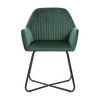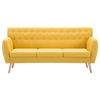Choosing the best console table
This versatile piece of furniture adds a touch of elegance and style to a room and offers practical storage solutions and display options for your treasured possessions. Whether you're looking to spruce up your hallway, add functionality to your living room or create a cosy nook in your bedroom, the right console table can make all the difference.
The allure of the console table
Console tables are long, narrow tables typically placed against a wall. They can serve various functions, from showcasing decorative items like lamps, vases or photo frames, to providing a convenient spot for keys and mail in an entryway. The beauty of console tables lies in their versatility; they can be used in almost any room of the house, adapting to many purposes and styles.
Determining the purpose and placement
Determining the purpose and placement of your console table is the first step in selecting the right piece for your home. This process involves considering how the table will be used and where it will best fit within your space.
Purpose: more than just aesthetic
The first question to ask yourself is what you need the console table for. This could range from purely decorative purposes to functional needs such as storage. Here are a few common purposes for console tables:
Entryway: Positioned in the hallway or entrance, a console table can serve as a welcoming element that sets the tone for your home. It can be a place to drop keys and mail or display decorative items that reflect your personal style.
Living room: In living rooms, console tables often stand behind sofas, acting as a divider in open-plan spaces or simply adding depth and interest to the room. They can hold lamps, books and decorative objects to enhance the living area's ambience.
Dining room: A console table in the dining room might serve as additional surface space for dishes during large gatherings or display space for decorative pieces that complement the dining area's decor.
Bedroom: In bedrooms, console tables can double as vanity tables, providing a spot for makeup and jewellery. With the addition of a mirror, it becomes a practical yet stylish corner for getting ready.
Placement: finding the best spot
After identifying the table's purpose, the next step is determining its placement. The right location not only ensures the table serves its intended function but also maintains the flow and harmony of the space. Here are some tips for placement:
Measure your space: Before choosing a console table, measure the area where you plan to place it. Consider the height, width and depth to ensure it fits comfortably without obstructing walkways or door openings.
Consider traffic flow: Placement should not disrupt the natural flow of movement through the space. In hallways and entryways, ensure there's enough room for people to pass by without bumping into the table.
Visual balance: In larger rooms, a console table can help balance out other large pieces of furniture or fill an empty wall. In smaller spaces, opt for a slim design that adds functionality without overwhelming the room.
Lighting and mirrors: Placing a console table near a light source can enhance its decorative appeal, especially if topped with reflective items like lamps or candles. Positioning a mirror above the console table in a hallway can make the space appear larger and brighter.
Choosing the right style and material
Choosing the right style and material for your console table is essential to ensure it complements your home's decor and meets your needs. This decision can significantly influence the look and feel of your space, as well as the durability and maintenance of the furniture. Let's delve into selecting the style and material for your console table.
Style: matching your home's aesthetic
The style of your console table should harmonise with the overall aesthetic of your home, whether that's traditional, contemporary, rustic or something uniquely personal. Here's how different styles can integrate into your space:
Traditional: Traditional console tables often feature ornate designs, including carved legs and mouldings, with rich wood finishes such as mahogany or cherry. They bring a sense of elegance and timelessness, great for homes with classic furnishings and decorative elements.
Modern: Modern console tables lean towards clean lines and minimalistic designs. They often incorporate materials like metal, glass or polished wood. They suit spaces with contemporary decor, adding a sleek and sophisticated touch.
Industrial: Characterised by combining wood and metal, industrial-style console tables add a raw, edgy vibe to your space. They work well in loft-style apartments or any home looking to add a modern yet rustic touch.
Rustic: Rustic console tables often use reclaimed wood or distressed finishes to add warmth and texture. Ideal for country, farmhouse or coastal interiors, they bring a cosy, lived-in feel to the room.
Material: Durability and maintenance
The material of your console table affects not only its appearance but also its durability and maintenance requirements. Here are the most common materials:
Wood: Wood is a classic choice that offers warmth and a natural feel. Hardwoods like oak, maple and walnut are durable and can last for decades with proper care. Softer woods or reclaimed wood pieces offer a more rustic appeal but may require more maintenance to prevent scratches and dents.
Metal: Metal console tables can vary from sleek and modern designs in stainless steel or aluminium to more industrial looks with wrought iron. Metal tables are durable and easy to care for, making them suitable for high-traffic areas.
Glass: Glass tables add a light and airy feel, making them ideal for smaller spaces or to create a minimalist look. They require regular cleaning to maintain their sparkle but are relatively robust, especially if made from tempered glass.
Functionality and storage solutions
When selecting a console table, you can consider its functionality and storage solutions — especially if you seek to maximise the utility of their space without compromising on style. Whether you're aiming to declutter your entryway, organise your living room or set up a media centre, the right console table can offer both aesthetic appeal and practical benefits.
Drawers: Console tables with drawers are ideal for storing smaller items out of sight, helping to maintain a tidy appearance. These are particularly useful in entryways for keeping keys, wallets and mail organised or in living rooms for remotes and gaming controllers. Look for tables with smooth-operating drawers that can accommodate your storage needs.
Shelves: Additional shelves can provide ample space for books, decorative items or baskets for organising miscellaneous items. This open storage solution allows for easy access and the opportunity to display cherished possessions or stylish storage containers. Consider the height and depth of the shelves to ensure they fit your intended items.
Cabinets: Some console tables feature cabinets, which are excellent for storing larger items or things you prefer to keep hidden. Cabinets can offer a more streamlined look by concealing clutter and can be particularly useful in dining areas for storing serving ware or linens.
Functionality for media and entertainment
If you're planning to use your console table as a media centre, functionality becomes even more critical. Here are some features to look for.
Cable management: Tables designed with cable management features, such as holes or channels for cords, can significantly reduce clutter and keep your space looking neat. This is essential for a media centre, where multiple devices may need to be connected to power sources and each other.
Appropriate dimensions: Ensure the table is of suitable height and width to accommodate your TV, speakers or other media devices. It should offer a stable platform for your electronics, with enough surface area to prevent overcrowding.
Ventilation: If you're storing electronic devices like game consoles or DVD players within the table, consider ventilation. Adequate airflow is vital to prevent overheating, so look for designs with open backs or ventilation holes.
Material and maintenance
While considering functionality and storage, don't forget to factor in the material of your console table, as this can affect its durability and maintenance requirements. Opt for materials that suit your lifestyle; for instance, glass or high-gloss finishes may require frequent cleaning to keep them looking their best, whereas wood or metal might offer more resilience to wear and tear.































































